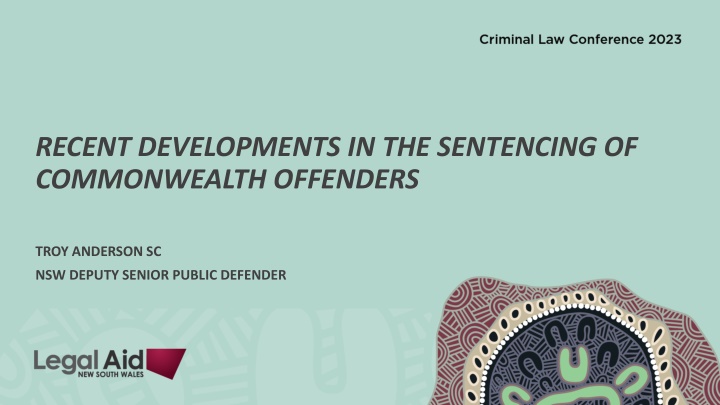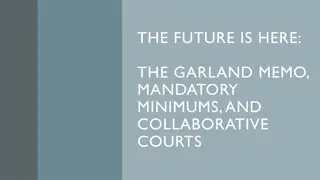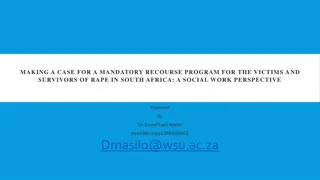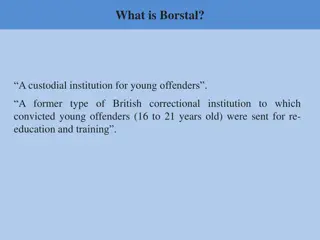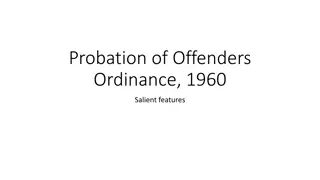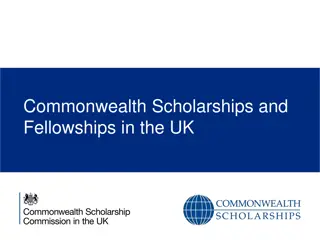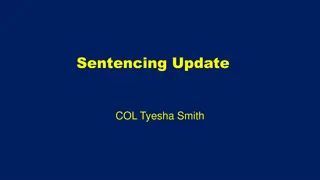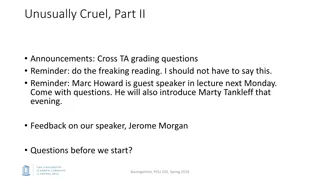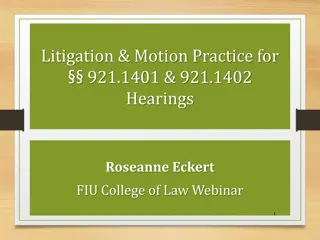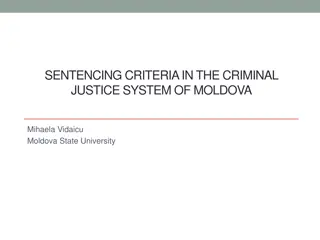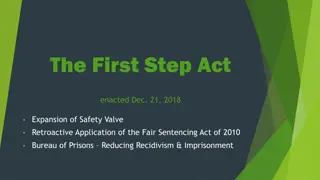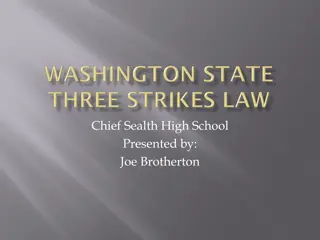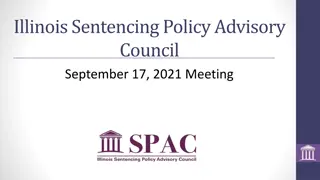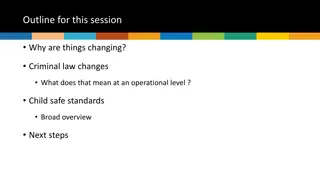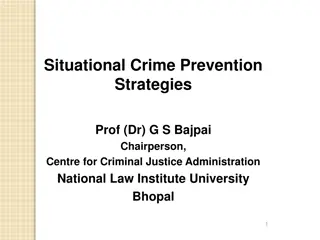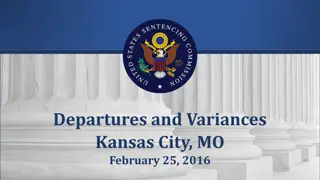Recent Developments in Commonwealth Offenders Sentencing and Mandatory Minimums
Explore recent sentencing developments for Commonwealth offenders in Australia including mandatory minimum sentences in specific offenses. Learn how to navigate Commonwealth sentencing laws, utilize helpful resources, and understand exceptions to mandatory terms of imprisonment for certain specified offenses.
Download Presentation

Please find below an Image/Link to download the presentation.
The content on the website is provided AS IS for your information and personal use only. It may not be sold, licensed, or shared on other websites without obtaining consent from the author.If you encounter any issues during the download, it is possible that the publisher has removed the file from their server.
You are allowed to download the files provided on this website for personal or commercial use, subject to the condition that they are used lawfully. All files are the property of their respective owners.
The content on the website is provided AS IS for your information and personal use only. It may not be sold, licensed, or shared on other websites without obtaining consent from the author.
E N D
Presentation Transcript
RECENT DEVELOPMENTS IN THE SENTENCING OF COMMONWEALTH OFFENDERS TROY ANDERSON SC NSW DEPUTY SENIOR PUBLIC DEFENDER
Remember to look beyond NSW As Commonwealth offences operate throughout Australia, do not hesitate to rely upon cases from interstate.
Useful resources for Commonwealth sentencing: Sentencing of Federal Offenders in Australia - A Guide for Practitioners - Sixth Edition, launched April 2023 and available at the CDPP website. Commonwealth Sentencing database, curated by the National Judicial College of Australia at https://csd.njca.com.au/ Public Defenders Chambers sentencing tables, available on the PD website. Commonwealth Criminal Law, 3rdEdition, Troy Anderson, published by Federation Press.
Mandatory Minimum sentencing Offences which contain mandatory minimum sentences are unusual within Commonmwealth offences. What began in 2001 in ss 232A and 233C of the Migration Act 1958 (Cth) is now a central part of the Commonwealth s offence provisions in Part 8 Divisions 272 (Child Sex offences outside Australia) and 273 (Offences involving child abuse material outside Australia); and Part 10.6 Division 474 (Telecommunications offences)
Context Divisions 272, 273 and 474 of the Criminal Code contain offences which potentially carry mandatory minimum sentences of imprisonment. Sections 16AAA and 16AAB of the Crimes Act 1914 (Cth) provide for mandatory terms of imprisonment for certain specified Commonwealth sexual offences relating to children which were committed on or after 23 June 2020 (subject to exceptions in s 16AAC).
Mandatory minimum sentences under s 16AAA or s 16AAB do not apply if the offender was aged under 18 years at the time of the offence: s 16AAC(1). Section 16AAC Crimes Act exceptions Under s 16AAC(2), a court may impose a sentence of imprisonment of less than the period specified in s 16AAA or s 16AAB but only if the court considers it appropriate to reduce the sentence because of either or both of the following: the court is taking into account, under s 16A(2)(g), the person pleading guilty; or the court is taking into account, under s 16A(2)(h), the person having cooperated with law enforcement agencies in the investigation of the offence or of a Commonwealth child sex offence. The maximum reduction below the specified minimum for either a guilty plea or cooperation is 25%, or 50% for both (s 16AAC(3)).
Section 16AAA relates to specified high-level Commonwealth child sex offences and applies in any case in which a person is convicted of a specified offence. Section 16AAB relates to specified Commonwealth child sexual abuse offences and applies if the offender has previously convicted of a Commonwealth, State or Territory child sexual abuse offence. Context
There are two schools of thought. Pot or Bahar How does mandatory sentencing work? R v Pot Wetangky and Lande ( Pot ) (unrep. Supreme Court NT, 18 January 2011) The Pot approach has a two stage test which required the sentencing Court to first consider the appropriate sentence in the usual way but NOT considering the statutory minimum sentence. If the notional sentence to be imposed is below the minimum, the statutory minimum will then be applied, lifting the sentence to the minimum.
What is the second approach? Bahar v R (2011) 45 WAR 100; [2011] WASCA 249 was a case involving offences under the Commonwealth s Migration Act. The sentencing judge is to have regard to the sentencing factors including the minimum sentence with the mandatory minimum sentence applying as a pre- determined baseline for cases involving the least serious offending. Bahar s approach has been favoured and whether that is the correct approach is the subject of Delzott v R, which is currently awaiting a hearing before the High Court.
It is being heard with Hurt v R [2022] ACTCA 49. Delzotto v R [2022] NSWCCA The NSW Court of Criminal Appeal held that (a) s 16AAB of the Crimes Act 1914 (Cth) applied to the Appellant and (b) the approach in Bahar v R [2011] WASCA 249; (2011) 45 WAR 100 ( Bahar ) applies to the interpretation of s16AAB. The first point was fact specific, ie, was the offence a subsequent offence . The more important issue is what effect the minimum sentence has in terms of setting the sentence. 117 The District Court convicted Mr Delzotto for two offences contrary to provisions of the Criminal Code (Cth) ( the Code ) relating to child abuse material under s 474.22A(1) and 474.22(1). Section 16AAB of the Crimes Act prescribed that one offence carried minimum 4 year custodial sentences when they have been convicted previously of a child sexual abuse offence.
The sentence in Delzotto The offences each had a maximum penalty of 15 years imprisonment. The indicative sentences specified by the sentencing judge, pursuant to s 53A(2)(b) of the Crimes (Sentencing Procedure) Act 1999 (NSW), were as follows: Sequence Offence and Section of Code (5) Possess child abuse material using carriage service s. 474.22A(1) (8) Access child abuse material using carriage services. 474.22(1) Sentence 2 years 9 months 18 months The starting point of the sentence for sequence 5, which attracted the minimum, was 4 years.
After allowing a total discount of 30%, comprising 25% for the plea and 5% for assistance, the was an indicative sentence of 2 years and 9 months. The sentence in Delzotto As the sentence began at 4 years, the District Court sentence did not fall below the minimum required to be imposed. He was sentenced to a single aggregate sentence of imprisonment for 3 years and 3 months with a non- parole period of 2 years and 2 months.
The Crown appealed against the sentence on two grounds; (i) manifest inadequacy and (ii) that: The Crown appeals Delzotto The sentencing judge erred in sentencing for Sequence 5 by imposing a sentence that did not reflect the sentencing principle that the mandatory minimum head sentence of 4 years imprisonment was for the least serious category of offending as set out in Bahar v R [2011] WASCA 249; (2011) 45 WAR 100 and Karim v R [2013] NSWCCA 23; (2013) 301 ALR 597. On 6 June 2022, the CCA then upheld the two grounds pressed by the Crown, determining that the approach in Bahar, and not Pot, applied.
Delzotto v R [2022] NSWCCA 117 Adamson J (with whom Beech-Jones CJ at CL; Hulme J agreed) held that: The approach in Bahar correctly reflected the legislative intent of the statutory minimum, ie, the sentences imposed for these offences should be increased. It is an approach that farer than Pot because because it means the minimum is reserved for the least serious case, whereas Pot could result in compressing a lot of matters at the bottom end of the sentencing despite their objective seriousness being different (a point made by Allsop P in Karim v The Queen (2013) 83 NSWLR 268 at [45].
Re-sentencing in Delzotto The CCA resentenced Mr Delzotto to an aggregate sentence of 4 years and 6 months with a non-parole period of 3 years. The indicative sentences specified by the CCA, after a total discount of 30%, were: Sequence Offence and Section of Code (5) Possess child abuse material using carriage service s. 474.22A(1) 4y 2m (8) Access child abuse material using carriage service s. 474.22(1) 18m Sentence
The respondent pleaded guilty to a single charge of using a carriage service to procure a person under the age of 16 for sexual activity. The offence was contrary to s 474.26(1) of the Criminal Code and carried a maximum penalty of imprisonment for 15 years. Section 16AAB of the Crimes Act subject to s 16AAC applied because Mr Taylor had been convicted previously of a child sexual abuse offence. A mandatory minimum sentence of 4 years imprisonment for the offence applied. Rex v Taylor [2022] NSWCCA 256
Rex v Taylor [2022] NSWCCA 256 The respondent was sentenced to imprisonment for 3 years with a recognizance release order to take effect after he had served 18 months of the sentence. The Crown appealed. The CCA dismissed the appeal (per Simpson AJA, Davies J concurring with additional remarks, Wilson J agreeing in part but dissenting in the result).
Rex v Taylor [2022] NSWCCA 256 Simpson AJA held that: (1) There is no legislative prescription that the mandatory minimum penalty can only be imposed where the offence in respect of which the sentence is to be passed is (expressly) characterised as within the least serious category of offending (quoting Bahar at [58]. Nothing in the decision of R v Delzotto adopts the proposition that unless a particular offence is (expressly) found to be within the least serious category of offending that a sentence in excess of the mandatory minimum must as a matter of law be imposed (subject to any reduction pursuant s 16AAC, Crimes Act 1914: ([54]-[56]; [67]- [70]; [72]; [78]).
Rex v Taylor [2022] NSWCCA 256 (2) Parameters of sentencing are set: First by any legislative requirements, and Secondly, by principles developed over the years by the common law. One common law principle to be applied is that the sentence imposed must properly reflect both the personal circumstances of the particular offender and the particular conduct with which the offender engaged when those circumstances and conduct are compared with other offenders and offending: ([57]-[60]).
(3) Where a minimum sentence has been legislatively prescribed, it must (like a maximum) operate as a yardstick. The prescription of a mandatory minimum term imports an additional constraint into the evaluation of proportionality, but it does not eliminate proportionality as an important sentencing consideration. The prescribed sentence does more than fix a boundary above or below which the sentence imposed may not go: [61]-[63]; [66]; [71] Rex v Taylor [2022] NSWCCA 256
The offender had pleaded guilty to two offences involving child abuse material (ss 474.22(1) and 474.22A(1) of the Criminal Code). Phibbs v The King [2023] VSCA 12 Charge 1 - use of a carriage service to make available child abuse material - involved the applicant and the other man discussing in explicit terms the sexual activities in which they had engaged with children and the sexual activities they wanted to engage in with children.
Phibbs v The King [2023] VSCA 12 Charge 2 possession or control of child abuse material obtained or accessed using a carriage service the photos involved: (a) a pre-pubescent male child performing fellatio on an adult male; (b) a pre-pubescent male child masturbating while another pre-pubescent male child watched; and (c) a pre-pubescent male child being held upside down by an adult male, which exposed the child s genitals, with the child about to perform fellatio. The original sentence for each offences was 6 months and 9 months respectively, to be served consecutively.
Phibbs v The King [2023] VSCA 12 The applicant submitted (successfully) that the sentence was manifestly excessive and that there should have been some accumulation. The sentence was reduced to 6 months. The Court stated at [51]: It is well established that all offences relating to the sexual abuse of children are very serious and that factors personal to an offender carry less weight than general deterrence and protection of the community. The courts recognise that significant lifelong harm is caused to children who are sexually abused. Accessing or possessing child pornography is not a victimless crime it is abhorrent because it supports a market for the production of images that involve the sexual exploitation of children. For these reasons, this Court has repeatedly emphasised that, ordinarily, persons who commit child pornography offences will be sentenced to an immediate term of imprisonment.
At [56] the Court noted the following important mitigating factors: his admissions to police, Phibbs v The King [2023] VSCA 12 guilty plea, genuine remorse, good prospects of rehabilitation and the fact that he instigated and paid for treatment, and continues to undertake that treatment.
In Totaan v The Queen the NSW Court of Criminal Appeal held that proof of exceptional hardship is not a precondition to a consideration of the effect of a sentence or order on family or dependants under s 16A(2)(p) of the Act. Totaan v The Queen (2022) 108 NSWLR 17; [2022] NSWCCA 75 Prior to the decision in Totaan v The Queen, sentencing courts throughout Australia (with the exception of the Act) had generally interpreted s 16A(2)(p) as operating consistently with the principle at common law that any hardship suffered by the person s family and dependants can only mitigate a sentence in exceptional circumstances .
Totaans effect However, the effect of Totaan may not be significant in practice. There are a number of authorities which were handed down prior to Totaan - and which Totaan did not challenge - which state that the objective seriousness of the offence may mean that the Court determines that the probable effect of the sentence on the person s family or dependants carries little or no weight.
AE v R [2023] NSWCCA 74 concerned the importation of a commercial quantity of cocaine. A post Totaan example: The sentencing court held that the applicant s role in the importation was essential and fundamental although there was no evidence to establish that the applicant was the financier or was to have been the distributor. His Honour concluded that the applicant was more than a mere warehouse man but less than a principal. As to the quantity, whilst large, the applicant could only be said to have known that more than 2kg of cocaine was involved.
AE v R [2023] NSWCCA 74 This is a post Totaan example of the objective seriousness negating family hardship. The sentencing judge inferred that the applicant expected a financial reward that was not insignificant . The guilty plea and assistance were regarded by the sentencing judge as evidence of contrition. The applicant s prospects for the future were held to be very good. The sentencing judge set out the applicant s personal circumstances, including his former good character, and the responsible and well-paid engineering positions he had held prior to arrest. His Honour noted the big effect on the applicant s elderly parents of his arrest and incarceration and the devastating effect on his children.
AE v R [2023] NSWCCA Wilson J at [52] [54] The sentence the applicant received in the District Court was one which, having regard to the seriousness of the offence and the maximum penalty that applies, might be regarded as lenient. Every conclusion favourable to the applicant that could have been reached was reached and, whilst the sentencing judge did not regard the evidence concerning the impact of the probable sentence upon the applicant s family as sufficient to constitute exceptional hardship, his Honour did not ignore it or fail to take it into account. The sentencing judge gave full weight to the big and devastating effect of the legal proceedings and the applicant s inevitable incarceration upon his parents and children and took it into account when determining the sentence to be imposed 74
Wilson J at [52] [54] AE v R [2023] NSWCCA The evidence before this Court as to the impact on family of the sentence imposed on the applicant bears out his Honour s conclusion in that regard. The applicant s family have been adversely affected as the sentencing judge predicted, a matter already given weight in mitigation by him when determining the sentence to be imposed. The additional evidence of the impact of the sentence upon family members is not such as to attract an even greater mitigatory benefit than that allowed at first instance. The situations respectively of the applicant s youngest child and his sister cannot result in a sentence that breaches the statutory requirement that the sentence imposed is of a severity appropriate in all the circumstances 74
The judicial gold star Section 16A(2)(h) of the Crimes Act requires the sentencing court to take into account, The degree to which the person has co-operated with law enforcement agencies in the investigation of the offence or of other offences. Although usually associated with cooperation with authorities, this can also manifest itself as a mitigating factor on sentence if the Court is in a position to find that, the offender was exceptionally co-operative and helpful and I record my gratitude ... I take into account in Ms Cranston s favour this important degree of co-operation in the conduct of the trial. R v Lauren Cranston [2023] NSWSC 454 at [88] R v Willmott [2023] NSWSC 474 at [85] R v Menon [2023] NSWSC 768 at [119]
